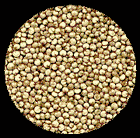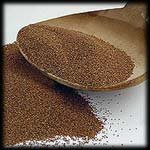Today we are going to be discussing some very ancient foods and how they will affect the performance of the strength athlete with internationally recognized holistic nutritionist Ian Murray.
Anthony Ricciuto: Ian it's an honor to have you here today with us at Powerlifting USA magazine.
Ian Murray: It's an honor to be here.
Anthony Ricciuto: Ian, tell us a little about yourself and some of your accomplishments.
Ian Murray: I am a Registered Clinical Sports Nutritionist and NSCA Certified Trainer. I am a faculty member of the Institute of Nutrition in Toronto, Canada where I teach courses in Sports Nutrition. In addition to providing seminars throughout Canada, I am a featured Nutritionist on the daily television series "Greco Health & Fitness." I also operate a private practice specializing in fitness and nutritional programs for amateur and professional athletes. I have also worked with some top level powerlifters on the Canadian scene.
Anthony Ricciuto: Today we are going to be discussing some very interesting foods that most strength athletes really aren't familiar with. Ian, could you expand on this?
Ian Murray: Yes, we are going to be taking an in depth look, into several different ancient grains and the role they can play in optimizing the performance of the strength athlete.
Anthony Ricciuto: What grains are these and what are some of the benefits the strength athlete could get out of incorporating them in their nutritional plan?
Ian Murray: Whether your goal is weight loss, strength gain or just setting a new personal best in your powerlifts, whole ancient grains need to be part of your daily diet. These grains are considered complete foods since they are not refined but in their natural state making them an abundant source of complex carbohydrates, vitamins, minerals and amino acids. Like most of us, we were brought up in the sports nutrition arena where we were told that the best source of energy (complex carbs) was oatmeal, potato or yams.
 I knew that our ancestors worked harder, lifted heavy all day long, conquered civilizations and built incredible monuments that still stand today. Their staple energizing food was not oatmeal, but what I would like to refer to as the Powerhouse Grains. It is time to put the oatmeal down and discover the powerhouse grains Teff, Quinoa, Amaranth and Millet.
I knew that our ancestors worked harder, lifted heavy all day long, conquered civilizations and built incredible monuments that still stand today. Their staple energizing food was not oatmeal, but what I would like to refer to as the Powerhouse Grains. It is time to put the oatmeal down and discover the powerhouse grains Teff, Quinoa, Amaranth and Millet.
Anthony Ricciuto: What made these grains so important to our ancestors?
Ian Murray: Grains were so important to our ancestors that they believed that each grain variety was a gift from the gods.
Anthony Ricciuto: Why should these grains in particular be a main staple in the powerlifter's diet?
Ian Murray: There are many reasons why these grains should be the foundation of your diet. They are an excellent source of complex carbohydrates. They are also high in protein and low in fat. These grains are loaded with fiber, vitamins, minerals as well as useful plant compounds called phytochemicals. The whole grain is the entire edible part of these grains. It is the seed from which other plants grow. Bran makes up the outer layer. It is rich in B vitamins, trace minerals and fiber. The inner part of the grain, the endosperm, contains most of the protein and carbohydrate, but only small amounts of vitamins and minerals. The germ is the very small part of the whole grain that sprouts a new plant. It is loaded with B vitamins, trace minerals and amino acids.
Anthony Ricciuto: Wow, these grains really do have a lot to offer the strength athlete. Could you give me a brief overview of each of these grains?
Ian Murray: I would love to.
Amaranth has a colorful history and is extremely nutritious. Amaranth was a staple in the diets of the Aztecs, who believed it had a supernatural power. Prior to the Spanish conquest in 1500, amaranth was used in human sacrifice ceremonies. Women made a mixture of amaranth; honey and human blood then shaped the mixture into idols that were eaten during the sacrifice. This practice offended the Spanish Conquistadors who believed that eliminating the amaranth would eliminate the sacrifices.
The grain was forbidden and fell into obscurity for hundreds of years. If it wasn't for the determination of a few remote areas of the Andes and Mexico that continued to cultivate amaranth, it may have become totally extinct and lost to us.
Amaranth grain is high in protein (15 -18 %) and contains good amounts of lysine and methionine, which are two essential amino acids that are not found often in grains. It is high in fiber, calcium, iron, potassium, phosphorous, vitamin A and C.
The fiber content of amaranth is three times that of wheat. Its iron content is five times that of wheat. It also contains twice the amount of calcium found in milk. The pale yellow seeds are smaller than mustard seeds and remain intact when cooked.
Anthony Ricciuto: Ian, what about Quinoa? It is no doubt my favorite of all the ancient grains. I personally have at least 1-2 cups throughout the day on all my heavy training days. It has made a major difference in my training as of late and I have incorporated it into some of my athlete's nutritional programs as well.
Ian Murray: Although new to North America, Quinoa has been cultivated in the South American Andes since 3,000 BC. The ancient Incas called it "The Mother Grain" and considered it sacred. Today, it is considered to be a super grain of the future. Quinoa contains more protein than any other grain. It is considered a complete protein because it contains all eight essential amino acids as well as high levels of calcium, phosphorous, iron and B vitamins.
In addition, Quinoa supplies valuable starch and fiber to the power lifting diet. Quinoa takes about 15 minutes to cook and will increase to three to four times in volume. As it cooks, the outer germ around each grain twists outward forming a spiral tail attached to the kernel. The grain itself is soft and delicate but the tail is crunchy, creating a great texture combination.
Cooked with extra fluid, Quinoa is extremely enjoyable as a hot breakfast cereal where you can add walnuts, raisins, molasses or anything you want. A nice bowl of quinoa will be a great energizing start to your day.
Anthony Ricciuto: What about some of the other grains like Teff and Millet?
Ian Murray: The name Teff means "lost", because if you drop it on the ground, you won't find it. Originating in Ethiopia, seeds of Teff have been found in the bricks of Egyptian pyramids dating back to 3300 BC.
 Ounce for ounce, Teff, the smallest grain in the world, supplies more fiber rich bran and nutritious germ than any other grain. It also has a mineral content that has 17 times more calcium than whole wheat or barley. It takes about 150 grains of Teff to weigh as much as one grain of wheat, which accounts for its high nutritional value. It's about twice the size of the period at the end of this sentence. In any grain, the nutrients are concentrated in the germ and the bran.
Ounce for ounce, Teff, the smallest grain in the world, supplies more fiber rich bran and nutritious germ than any other grain. It also has a mineral content that has 17 times more calcium than whole wheat or barley. It takes about 150 grains of Teff to weigh as much as one grain of wheat, which accounts for its high nutritional value. It's about twice the size of the period at the end of this sentence. In any grain, the nutrients are concentrated in the germ and the bran.
With Teff, the germ and the bran make up the bulk of the grain, and because it's too small to hull, its nutrients stay intact. Teff contains two to three times the iron of wheat or barley. Teff contains 15% protein, 3% fat and 82% complex carbohydrate.
There are three varieties of Teff, white, brown and red. Each has almost a nutty flavor. The white is chestnut in taste; the darker colours are earthier and taste like hazelnuts. Brown Teff makes incredible breakfast porridge. When preparing Teff, use 4 cups of water to one cup of grain. Add nuts, raisins, honey, the choices are endless. The Ethiopians use Teff flour to make their staple bread, Injera. Teff is the only grain to have symbiotic yeast. Like grapes, the yeast is on the grain, so no yeast is added to the preparation of Injera.
Anthony Ricciuto: I heard that millet was actually the main grain used in China even before white rice became the norm. Is this true?
Ian Murray: Millet was possibly the first cereal grain to be used for domestic purposes and the staple food in China before rice was introduced about 12,000 years ago. Millet has aroused the interest of food experts, such as in the case of the Hunza tribe where millet is a staple food in their diet. The Hunzas are a remarkable culture living in the Himalayan foothills and are known for their longevity and excellent level of fitness. Millet is well-balanced in essential amino acids and has more iron than any other grain. The protein value of millet is greatly increased by adding legumes. To cook millet, bring 4 to 5 cups of water to a boil and add 1 cup of millet. Lower the heat and simmer for 15 minutes.
Anthony Ricciuto: Ian could you give the readers a few recipes on how to put them together so they can be incorporated in their power meal plan?
Ian Murray: I would love to. Here are a few of my personal favorites. Give them a try and let me know your feedback.
-
Teff-Millet Casserole
1 cup of millet
1/2 cup of teff
Put these two grains into 5 cups of water.
Add a pinch of sea salt
Put in 2 sliced onions or leeks
Dice 1 butternut squash cut into bite size chunks
2 cloves of chopped garlic
Bring to a boil then simmer for 20 minutes
Power Breakfast
One cup of any ancient grain
Add 2 cups of water (4 cups if using teff)
Bring to a boil and simmer for 20 minutes
Add nuts, honey, raisins and almond milk for a daily variety.
Super Shake
1/2 cup of cooked quinoa
40 grams of chocolate whey protein
12 oz. of skim milk
Anthony Ricciuto: What are some of the performance benefits that you have personally seen with your athletes?
Ian Murray: First off, I have seen a major improvement in my athlete's energy levels. This is not only throughout the day but also during their training. Their volume and workload capacity has seen a major difference even during the first week of their consumption. After being on the grains consistently for approximately a month, you will notice its effects to a greater degree. I have noticed a much more balanced blood sugar level when they are consumed, especially with my athletes that suffer from hypoglycemia as well as those that run into these problems because of their poor nutritional practices.
Anthony Ricciuto: Ian, you are definitely familiar with the protein needs of powerlifters, do you think that these grains can provide an excellent source of non meat protein?
Ian Murray: Yes, the above mentioned grains are no doubt the best sources of protein when compared to any other grain or vegetable source. The quality is unparalled, the amino acid spectrum is more complete, and the content is higher.
Anthony Ricciuto: Where can powerlifters get these grains?
Ian Murray: All these grains can be found at health foods stores. Be sure to purchase only organic to ensure you are getting the original ancient grain that our ancestors used. All these grains can be combined with any food where you may have used complex carbohydrates in your daily eating regime.
Anthony Ricciuto: So there is no doubt that these ancient grains can make a major difference in the performance of the powerlifter when incorporated into their nutritional program.
Ian Murray: Whatever way you chose, give ancient grains a serious try - they are easy to use, taste great, and will provide sustained energy for hours. These grains would give any strength athlete a competitive edge on competion day, as well as in their training.
Anthony Ricciuto: Ian it has been a pleasure conducting this interesting interview. Mike Lambert and I would like to thank you for this very informative session that has shed some light on how the powerlifter can incorporate ancient grains into their nutritional program.
Ian Murray: No problem, any time. If anyone is interested in finding out more information about these ancient grains or has any questions in regards to this interview please feel free to write me at lifeworksclinic@aol.com.
